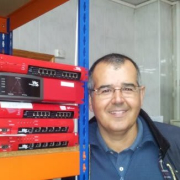I'm a wireless engineer. I do both troubleshooting and design. I use NetAlly EtherScope nXG mainly as a troubleshooting device, and I also use it to collect data so that when I do my designs, I have all of the data that I need.
One of the great things about it is that it is a small and portable device. We're based in London, and we had a customer in New York. We were finding it really difficult to troubleshoot a problem remotely even though we had cloud-based controllers and other things for wireless. It was an intermittent problem that was difficult for us to replicate. So, I ended up sending the device to the customer. They were able to set it up and plug it in. Because it can charge over PoE, they were able to just leave it there, and then effectively, I could log into that device through Link-Live. I could run all the tests that I needed to run. I could have the AutoTest running for 24 hours, and then I could look at that data. We figured out what the problem was. I was able to do remote packet captures and other things. We were able to fix the problem, and they just shipped the unit back to us. That was obviously much cheaper than me flying over to New York for two weeks. I could carry on with the work that I was booked into day to day, but I was also able to log in and look at things over there. It was really useful to be able to just send that device and get that fixed. It has basically enabled me to be in two places at once, which is invaluable. There aren't a lot of wireless engineers. So, the fact that I can be both in New York and in London at the same time is the value that we are getting from it.
It is easy to use for less skilled staff but has deep diagnostics for experts on staff. I told the customer at the New York site to just walk around with it and let it do everything it needs to do because I'm connected via wireless. After walking around, they said that this is a problem area, and then effectively, I could just run the device. For something simple, I could get them to click on something, but if I wanted to run more of a test, I could just remotely use the device. I told them, "Stick this in the middle somewhere and make sure it has got PoE power. I can run everything I need to run. Don't worry about it, and when I've got everything I need, just ship it back to me."
Its multi-technology functionality when it comes to validating network changes, troubleshooting connectivity, and detecting performance issues is very helpful. A lot of the time, it is proving that it isn't a Wi-Fi problem. The nice thing about having a product that has all of it in there is that I can test not just the wireless; I can also test up the stack. If everything looks good from the wireless side, I can then start to troubleshoot up the stack. No other product that I have gives me that flexibility.
I create my own tests. The test is different for each site depending on what I am troubleshooting or what applications they're using. To be able to just leave something and collect data over time is really valuable.
I have made use of its full line-rate 10 Gig capability. Because I've two nXGs, I can use the LANBERT tester as well. I've done that a few times where customers have got pre-existing cabling, and they said that they will have to completely rip out the cabling to be able to go with the new 6 GHz APs and things like that. In such cases, I've been able to just test that cabling and tell them that this cabling will be absolutely fine. There is no need to rip it out, which obviously makes the customer quite happy because it means that they don't have an additional cost of re-cabling everything.
It is a handheld tool, which makes it easy to use, and you do use it. Some of the other tools that we have are great tools, but because they're cumbersome and they require you to put lots of things in and have lots of extra things attached to them, you only use them if you absolutely have to, whereas you can use this tool every time because it is portable and easy.
The AirMapper Site Survey app is brilliant at gathering WiFi site survey data, and the Link-Live service that you have afterward is the crown jewel of it. You can easily share that with customers. All that data is readily available on any platform, which is really good. I can use an iPad, I can use a Mac, or I can use a Windows device. It doesn't matter.
The Link-Live part of the whole system is very good. You can build up reports. You can create heat maps, and you can have all that other data in there as well. You can have raw test data, and you can have your discovery data. It is all there in one place, and then you can easily share that with customers. It is very good in terms of the ability to visualize key performance metrics. It has got everything we need, and it is clear for customers too.
It impacts our ability to validate changes or troubleshoot problems. I use it for both. It has the data, and I can also see the before and after. I can go onsite really easily and collect that data. I can then make changes based on the recommendations and then go back to the site and see the difference between how it was before and how it is afterward. Being able to display that and easily show that to the customer is a great thing, and I'm not printing off 100-page reports. I can just send a link.
It has provided visibility into the network that we could only get by using many other tools. It has both the wireless and the wired in one device, and that's the thing that separates it from anything else on the market. You get some really good wired devices. You get some really good wireless-only devices. This is the only one that I've come across that has not just both of them but also a lot of detail and a lot of expertise in both of those areas. It has affected the efficiency and cost of our network troubleshooting massively. I didn't have to fly to New York for two weeks. It is helpful for the remote support that we can offer to customers. It is so much easier for us to send that device than it is for us to send a Level 3 or Level 4 engineer.
It has reduced the troubleshooting time. Now, I can walk onto the site and within a couple of minutes, I'm able to determine if this is a wireless problem or a wired problem. I still have everything I need to fix that problem, whereas previously, I would either have to take a lot of equipment with me, which is expensive and a hassle, or I would turn up thinking it is a wireless problem and not have the other equipment with me, and then I would have to come back another day or book in another session. I don't have the actual number of time saved, but I wouldn't go anywhere without this equipment now.
The things that I find most valuable are the Wi-Fi app and the Discovery app. Those two things help a lot when I'm doing the initial discovery of a space. I also use the AutoTest feature quite a lot, especially if I'm troubleshooting.
It is one of the best solutions for finding network problems quickly. The Discovery app that I use as I'm walking around the site picks up loads of things such as retries, APs that are using wrong channels, APs that are moving channels regularly because of DSS events, etc. That's one of the best features that I use the most.
We should be able to do online wireless design through Link-Live. We should be able to take the information that we've gathered and send a customer the way to fix it, in terms of moving APs and how that would affect things, within Link-Live.
The ease of use of AirMapper could do with some improvements. I don't use the AirMapper Site Survey app a lot. I have used it recently with the new 6 GHz device because effectively, it is the only device I have that can do that. For most of my site surveys, I use a different tool. AirMapper is very quick and easy once everything is on there, but I would like to see an improvement on how you get things on there. Currently, rather than being able to build up buildings or a site of things, every map is an individual piece. We should be able to set up an AirMapper survey easily and more effectively. At the moment, we just have separate floor plans. It'd be great to be able to build a building and tell where different floors are so that if it hears an AP on the floor below, it doesn't put two APs, one on that floor and one on the other floor, and it knows that there are two floors here. One is on top of the other, and it won't put the AP at both places. It would put it on one of the floors where it would be strongest. This would be one of the biggest improvements.
I've got two of these. I've been using them for about three years. I'm currently using the 6 GHz model.
It is very stable and reliable. I've never had a crash, and I've never had it not collect data. It has always been rock solid.
I've never had to use their support. Their documentation is good, but the main place I've gone to find out how to do things has been YouTube. When there is a new feature, or there is a webinar that's being recorded, I can just watch that back on YouTube.
I've added the NetAlly solution to what I already had. It is not replacing these, but it is better than the tools that I still take with me. I'm a wireless engineer rather than a wired engineer, and I didn't have any Fluke or Netscout products previously. I don't have a wired networking tester. I do have Ekahau, and I still use that. With NetAlly, I've now got additional capability that I didn't have previously. I used to have a separate device for doing packet captures, which effectively is just my laptop with USB wireless cards plugged into it, and now, I don't use that. I just use EtherScope nXG.
In terms of the return on investment, when you use it onsite once or twice, it has already paid for itself. I've said to people that it makes your life so much easier when you're onsite, especially if you're troubleshooting, that it doesn't make sense to not pay for it.
The main benefit is that it just saves time. It saves time on the site. Because it is a handheld device and I can walk around with it, I don't have to walk around with my laptop everywhere. My site visits now are 50% of what they were previously because I'm able to gather that data at the same time. I'm not having to go back and use different tools or take lots of different things to do it. This one tool allows me to do it all in one go or one sweep of the building. A site survey that might've taken two days can be done in a day now. It takes me less time, and I can charge more per day. It also means that on the second day that I would've been there, I can be on another site, effectively earning money twice.
It is worth it. The cost benefit of Link-Live is massive because it is included with the cost of the device and the licensing. A lot of people miss that part of it. It is not just the device that you get but it is the ability to look at all of that data later on. You're not having to do all of that on the device. You can just be there, use the device, and then look at the data from the comfort of your office or home afterward.
I am currently the only user of this equipment, and I also take care of its maintenance. I've planned an internal demo of the equipment for some of the other engineers in the company. Some of our NOC engineers and some of our wired engineers could really use something like this.
It is relatively easy to learn. There are a lot of videos and other resources that you can check out. A lot of the content is pretty intuitive. The only issue is that because there is so much there, people might feel that they don't really understand where to start with this. However, if people have a particular problem they're trying to solve, they will be able to figure out how to solve that because it has everything they need. There is just so much in there that when people first start out, they won't necessarily know where to go to check something out, but most people who are buying this type of solution would be savvy enough to open everything, figure out where everything is, and then go with it. I certainly had no problem.
I would rate it a nine out of ten.







